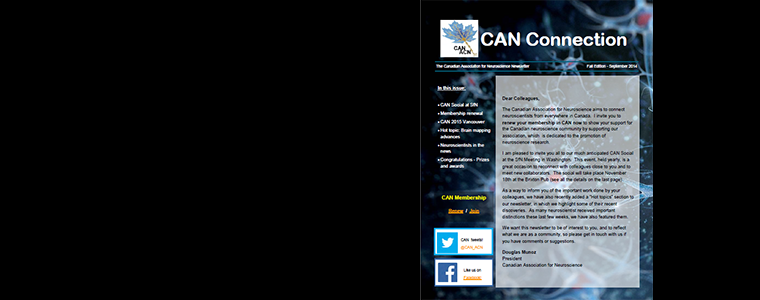
CAN Newsletter
Read our latest news in CAN connection: CAN Connection – Fall 2014

CAN Newsletter
Read our latest news in CAN connection: CAN Connection – Fall 2014

The original paper about the Nobel-winning discovery was published by John O’Keefe and Jonathan Dostrovsky, Past President and Honorary Member of CAN. Read more on the Nobel prize website.

Frédéric Charron, CAN 2012 Young Investigator, publishes in Developmental Cell.
Researchers at the IRCM show that a protein called Sonic Hedgehog causes DNA damage – They discovered a mechanism that promotes the progression of medulloblastoma, the most common brain tumour found in children. Continue reading

According to a study conducted by pediatricians and researchers at Sainte-Justine University Hospital Research Center (Sainte-Justine) and Université de Montréal published online in the prestigious medical journal Nature Medicine on September 14, 2014, Continue reading

Researchers at Western University have extended their game-changing brain scanning techniques by showing that a short Alfred Hitchcock movie can be used to detect consciousness in vegetative state patients. Continue reading

When you reach into your pocket, you can easily tell a button from a coin. Solving this seemingly simple problem is actually amazingly complicated. The long-held scientific explanation is that neurons in the cerebral cortex, which is the part of the brain reserved for the most complicated functions, make the differentiation but recent findings Continue reading

Dopamine plays a key role in decisions involving risk and reward, says UBC’s Stan Floresco.
A gambler’s decision to stay or fold in a game of cards could be influenced by a chemical in the brain, suggests new research from the University of British Columbia. Continue reading

It’s in the brain where we perceive the unpleasant sensations of pain, and researchers have long been examining how calcium channels in the brain and peripheral nervous system contribute to the development of chronic pain conditions. Continue reading

In a new study published 2 September 2014 in the scientific journal Neuron, Sam David and his team at the Research Institute of the McGill University Heath Centre shed light on why inflammation after nervous system injury, such as spinal cord trauma, worsens damage and functional loss. Sam David says that “a cytokine called tumor necrosis factor (TNF) and iron from red blood cells that are phagocytosed by macrophages favours a prolonged shift to harmful pro-inflammatory type of macrophage that is detrimental to recovery.” Continue reading

Research by Dr. Sylvain Williams shows that the flow of activity in the hippocampus, a brain region essential for memory, is actually bidirectional, rather than just unidirectional
A study just published in the prestigious Nature Neuroscience journal by Sylvain Williams, PhD, and his team, of the Research Centre of the Douglas Mental Health University Institute and McGill University, opens the door towards better understanding of the neural circuitry and dynamic mechanisms controlling memory as well of the role of an essential element of the hippocampus – a sub-region named the subiculum. Continue reading